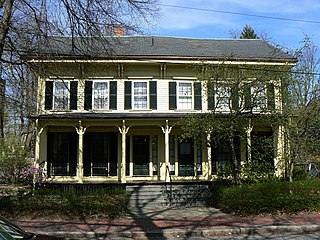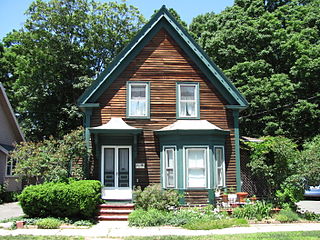
The E. H. Brabrook House is an historic duplex house in Cambridge, Massachusetts. It is a two-story wood-frame structure, six bays wide, with a side gable roof and a porch extending across its front facade. It was built in 1849 by Ezra Brabrook, a local furniture dealer. It is one of the first Italianate houses in Old Cambridge, retaining distinctive Greek Revival characteristics such as its corner pilasters and front door sidelight windows, while including an Italianate wide cornice and brackets.

The Isaac Melvin House is a historic house at 19 Centre Street in Cambridge, Massachusetts. This 2+1⁄2-story Greek Revival-Italianate house was built in 1842 by Oliver Wood and Isaac Melvin as the latter's home. Melvin is also notable for designing the North Avenue Congregational Church. Despite an Italianate T-shaped massing, the building's front facade is strongly Greek Revival, with 4 two-story pilasters supporting an entablature and topped by the fully pedimented gable end of the roof. The tympanum of the pediment has an Italianate round-arch window in it.

The Ivory Sands House is a historic house in Cambridge, Massachusetts. It is a two-story brick structure, five bays wide, with a side-gable roof. It was built in 1839, and has transitional Federal-Greek Revival styling. It was the first of four brick houses built by a local family of brickmakers, and is one of the few surviving Federal period brick houses in the city. The Sands family were involved in Cambridge's brickmaking businesses for most of the 19th century.

The Ashland Town House is the current town hall of Ashland, Massachusetts. It is located at 101 Main Street, in the town center. The 2+1⁄2-story wood-frame building was built in 1855, and has been used continuously for municipal purposes since then. It is a fine local example of Greek Revival architecture, with some Italianate and Colonial Revival details. The building was listed on the National Register of Historic Places in 2004.

The Amos Keyes House is a historic house in Somerville, Massachusetts. This 2+1⁄2-story wood-frame house was built c. 1860 by Amos Keyes, a produce dealer. It was originally located on Central Street, but was moved to this location c. 1870 when Keyes sought to build a larger house on the other site. This house exhibits both Greek Revival and Italianate features: the round arch window in the gable is a typical Italianate detail, but the side-hall three-bay layout of the house is Greek Revival, as is the Doric porch.

322 Haven Street in Reading, Massachusetts is well preserved cottage with Gothic and Italianate features. Built sometime before 1889, its use of even modest Gothic features is unusual in Reading, where the Gothic Revival was not particularly popular. The house was listed on the National Register of Historic Places in 1984.

The House at 42 Salem Street in Reading, Massachusetts is a transitional Greek Revival-Italianate house. Built sometime before 1854, its gable end faces the street, with the door on the left bay of three, a typical Greek Revival side hall layout. The doorway is topped by a heavy Italianate hood. The windows have shallow pedimented lintels, and the left facade has a projecting square bay. The house was occupied for many years by S. H. Dinsmore, a cabinetmaker who originally worked from a shop in the rear of the property and later moved to a larger space a short way down Salem Street. The house is typical of small industry that developed along Salem Street in the second half of the 19th century. It is next door to the Washington Damon House.

The A. Kinney House is a historic house located in Southbridge, Massachusetts.

The William Griffin Fuller House is a historic house at 32 Franklin Street in Stoneham, Massachusetts. The two-story wood-frame house was built c. 1850 for William Griffin Fuller, a real estate developer and trustee of the Stoneham Five Cent Savings Bank. Its features are transitional, including both Greek Revival and Italianate details. The five-bay facade and single-story porch are Greek Revival, and the bracketing in the eaves and gable ends is Italianate in style.

The Marcus Hobbs House is an historic house at 16 William Street in Worcester, Massachusetts. Built in 1849, it is an example of mid-19th century Greek Revival housing with added Italianate features. The house was listed on the National Register of Historic Places in 1980.

The Perez Smith House is a historic house at 46 Lincoln Street in Waltham, Massachusetts. The 2½ story wood-frame house was built in 1851 and is one of the city's finest transitional Greek Revival/Italianate houses. It has a typical Italianate three-bay facade, deep cornice with decorative brackets, and round-arch windows in the gable. It also has Greek Revival pilastered cornerboards, and its center entry is flanked by sidelight windows and topped by a transom window and paneled sunburst. Its windows are topped by heavy corniced lintels.

The East Main Street Historic District is a small residential historic district in Waltham, Massachusetts. It encompasses part of an area that was, before the 1813 construction of the Boston Manufacturing Company further west, developing as a center of the community. Because of the company's economic influence, the center was more fully developed further west, and East Main Street became a fashionable area for upper class housing. The four houses on the south side of East Main Street between Townsend Street and Chamberlain Terrace are a well-preserved remnant of this later period. The district was listed on the National Register of Historic Places in 1989.

The House at 196 Main Street is a historic house located at 196 Main Street in Wakefield, Massachusetts.

The House at 7 Salem Street in Wakefield, Massachusetts is a transitional Greek Revival/Italianate style house built c. 1855–57. The 2+1⁄2-story wood-frame house has a typical Greek Revival side hall plan, with door and window surrounds that are also typical to that style. However, it also bears clear Italianate styling with the arched window in the gable, and the paired brackets in the eaves. A single-story porch wraps around the front and side, supported by simple square columns. Its occupant in 1857 was a ticket agent for the Boston and Maine Railroad.

The E. M. Phillips House is a historic house at 35 Dresser Street in Southbridge, Massachusetts. The two story L-shaped house was built in 1871 for E. M. Phillips, a local insurance agent. Its styling is Italianate: its main body is three window bays wide, there are brackets in the eaves and gable pitch, and the gables have small round-arch windows. After Phillips, the house was briefly occupied by Herbert E. Wells, son of Hiram C. Wells, owner of the locally important American Optical Company. The company later acquired the house and used it as employee housing.

The house at 38–40 Webster Place in Brookline, Massachusetts, is a rare local example of transitional Greek Revival-Italianate styling.

The House at 53 Linden Street in Brookline, Massachusetts, is a well-preserved local example of transitional Greek Revival-Italianate styling. The 2+1⁄2-story wood-frame house was built c. 1843–44 by John Faxon. It has a pedimented gable front with pilasters, but is L-shaped and has round-arch windows in its gables, both Italianate features. It is one of four surviving Greek Revival houses in the neighborhood, which was developed beginning in 1840.

The Ginery Twichell House is a historic house located at 17 Kent Street in Brookline, Massachusetts.

The Bridge Avenue Historic District is located in a residential neighborhood on the east side of Davenport, Iowa, United States. It has been listed on the National Register of Historic Places since 1983. The historic district stretches from River Drive along the Mississippi River up a bluff to East Ninth Street, which is near the top of the hill.

The Lucinda Hunter House is a historic house located at 101 East 8th Street in Vermont, Illinois, United States. The house was built in the early 1870s for Lucinda Hunter, the mother of village postmaster John Hiram Hunter. The house is an example of the Gable Front type of the Side Hall plan, a vernacular style popular for much of the 19th century. The Side Hall plan as exhibited in the house features two rooms on each story connected by a hall to the side; the Gable Front type reflects its roof form, a gable roof with a front-facing gable. Elements of several popular architectural styles decorate the house, such as the Greek Revival entrance, Italianate arched windows, and Gothic pointed arches on the porch.























